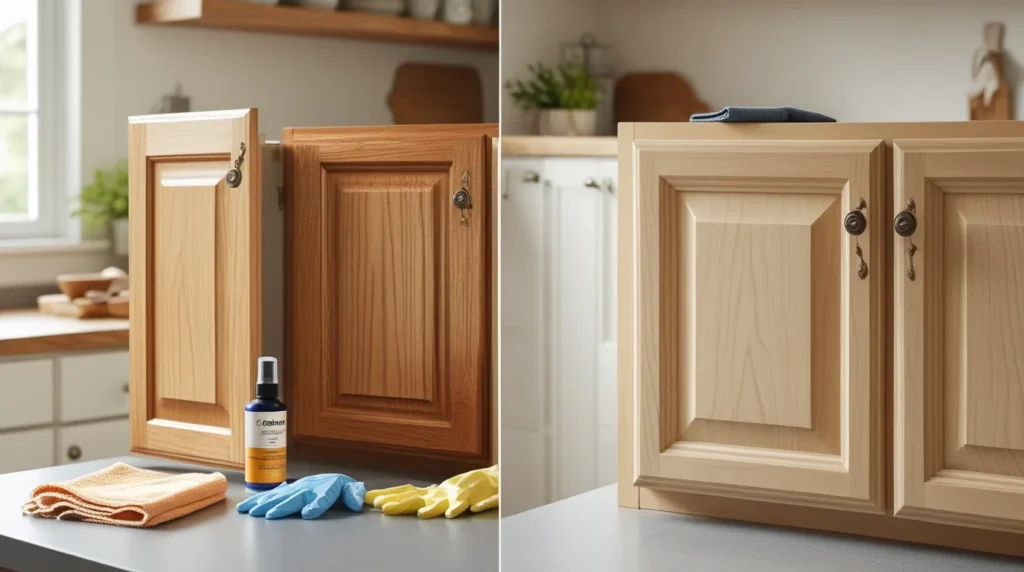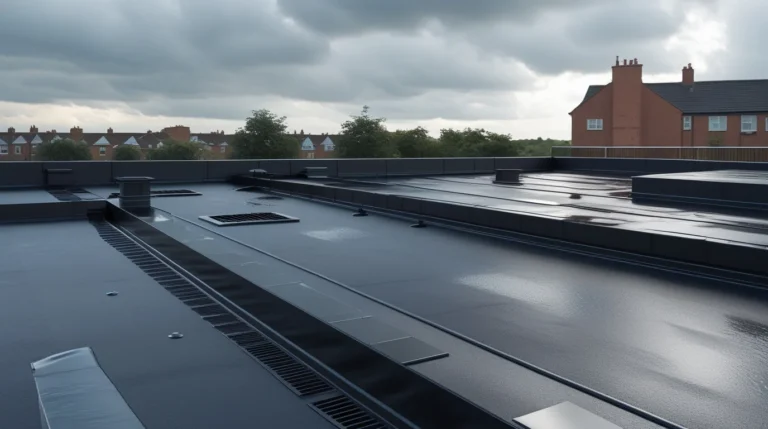Why Restoring Kitchen Cabinets Can Transform Your Home
Your kitchen is one of the busiest places in the house. Over time, your cabinets can get scratched, dull, and stained. You may think the only way to fix them is by sanding and varnishing, but there’s an easier way. In this guide, we’ll show you how to restore kitchen cabinets without sanding & varnishing so they can look new again without all the mess and effort.
Restoring kitchen cabinets can bring new life to your space without the cost of a full remodel. It also helps save wood, reduce waste, and improve the look of your kitchen. Even old cabinets can be made to shine again using simple tools and cabinet restorer products.
Many people don’t realize you can clean, refresh, and protect your cabinets without using sandpaper or heavy chemicals. It’s faster, safer, and great for anyone doing it for the first time. If your cabinets still have a solid structure, this method is perfect.
Whether your goal is to sell your home or enjoy a fresher look for yourself, this process will help. With a little time and care, even worn wood cabinets can look beautiful again.
Understanding Cabinet Restoration Without Harsh Methods
Sanding and varnishing take a lot of time and create dust and strong smells. If you don’t want that, there are other ways to restore kitchen cabinets that are safer and easier.
Restoring without sanding means you clean the wood well, fix the small spots, and use cabinet restorer or touch-up stain to bring the color back. You don’t strip away layers of wood or paint. This makes the job simpler and keeps your cabinets strong.
Many kitchen cabinet restoration kits are made for this kind of work. These kits often include cleaners, wood polish, and finish protectors. Some even hide small scratches and fill in faded areas. You don’t need to be a pro to use them—just follow the steps.
The reason this works is that most cabinet damage is on the surface. It’s caused by grease, fingerprints, sun, or water. A deep clean and good finish restorer can make a big difference. This also works well if you want to restore wood kitchen cabinets that are still in good shape.
So don’t worry if your cabinets look old. As long as they aren’t broken, there’s a smart way to restore them without sanding them down.
Tools and Products Needed to Restore Cabinets Without Sanding
You don’t need big machines or special tools to do this job. Most of what you need is already in your home or is easy to buy at a store. Here’s a list:
- Soft cleaning cloths or microfiber towels
- Mild soap or cabinet cleaner
- Warm water
- A small brush or toothbrush
- Cabinet restorer product
- Protective gloves
- Painter’s tape
- Wood filler or scratch repair marker (optional)
You might want to buy a product like rejuvenate for cabinets or any brand that says “restore finish on kitchen cabinets.” These help bring back the shine and color. If you want to change the color, you can also try restaining cabinets without sanding using gel stains or touch-up solutions.
Make sure you use gloves to protect your hands. You can also use painter’s tape around the cabinet edges to protect your walls or counters. Always test new products on a small spot first.
Some people use kitchen cabinet restorer kits that come with everything inside, including touch-up paint and a sealer. They’re made for homeowners who want to get the job done without hiring help.

How to Clean and Prep Kitchen Cabinets for Refinishing
Cleaning is the most important part. If you skip this step, the restorer won’t work well. Over time, cabinets collect grease, food, dust, and fingerprints. These things stop the new finish from sticking.
Here’s how to prep:
- Take off the doors and hardware – Unscrew the cabinet doors, knobs, and handles. Put them in a safe place.
- Wipe down with warm, soapy water – Use a soft cloth and mild soap to remove grease and grime.
- Scrub corners and edges – Use a small brush to clean hard-to-reach spots.
- Dry with a clean towel – Make sure everything is fully dry before going to the next step.
- Use a cabinet cleaner or degreaser – This helps remove anything soap didn’t get.
After cleaning, let the cabinets air out for at least 30 minutes. If there are deep scratches or stains, you can fill them with wood filler or use cabinet touch-up paint.
This step also helps with how to remove stain from cabinets without sanding. By getting rid of surface oils, you make room for the new finish to soak in and stay.
Step-by-Step Guide: How to Restore Kitchen Cabinets Without Sanding and Varnishing
Now that everything is clean and ready, it’s time to restore the cabinet finish. Follow these easy steps:
- Choose your restorer – Pick a good-quality product designed to refresh wood cabinets.
- Apply with a soft cloth – Dip the cloth into the product and rub it onto the wood in the direction of the grain.
- Work in small sections – Don’t rush. Take your time to coat each area evenly.
- Buff the surface – After applying, take a clean towel and gently rub the area to remove extra product.
- Let it dry – Most products need about an hour to fully set.
If you want to restain kitchen cabinets without sanding, use a gel stain. It goes right over the old finish. Just apply with a cloth or brush and wipe off the extra stain. Wait for it to dry fully before adding a sealant.
This process works well for refinishing cabinets without sanding, making them look almost like new again. It’s great for cabinets that are still strong but just look dull or faded.

Best Methods to Restore Cabinet Finish Without Removing Stain
If you like the color of your cabinets but want to make them shine again, you don’t need to remove the stain. You just need to clean and use a restorer that brings out the color.
Here’s how:
- Use a no-sanding cabinet refinishing product
- Apply it with a sponge or cloth.
- Let it sit and soak into the wood.
- Wipe off any extra liquid.
- Repeat if needed
This is good for restoring old cabinets that have dry patches or small nicks. You don’t need to worry about stripping the stain or sanding it off.
Also, avoid heavy waxes or polishes. Stick with cabinet-specific products made for wood cabinet restoration. These keep your finish looking rich and healthy without making it greasy.
How to Restain Cabinets Without Sanding or Stripping
Want a darker color or fresh stain without sanding? It’s possible!
- Clean the surface well.
- Lightly scuff with a non-scratch pad (optional for better hold)
- Use gel stain or cabinet stain without sanding.
- Apply with a cloth and rub it i.n
- Let it dry for a full day
- Apply a clear sealer if needed.
This method works for how to refinish kitchen cabinets without sanding when you want to change the tone a little, but don’t want a full teardown. Just be sure to match the stain color with your current shade or go a little darker.
Using Cabinet Restorer Products for a Fresh, Updated Look
Many stores sell cabinet restorer products that work in just one step. These are good for beginners or quick updates. They clean, shine, and protect the cabinets all at once.
Some benefits include:
- Easy to use
- Safe for wood and laminate
- No smell or mess
- Works fast
Products like Rejuvenate for cabinets are made for this exact job. They help renew wood cabinets by giving them moisture, hiding scratches, and protecting them from future wear.
These products are perfect if your cabinets are dry, dull, or scratched but still solid and strong.

Common Mistakes to Avoid When Restoring Old Cabinets
Restoring cabinets is easy, but there are some things to avoid:
- Skipping cleaning – This causes the restorer or stain not to stick.
- Using too much product – This can make the surface sticky or streaky.
- Not waiting between steps – Let each layer dry fully.
- Wrong product for wood type – Some finishes work better on oak, maple, or cherry.
- No gloves or tape – Always protect your skin and nearby surfaces.
Also, if you’re trying to redo old wood kitchen cabinets, don’t rush. Take your time and work in small sections. This helps prevent mistakes and gives better results.
How to Maintain Restored Wood Kitchen Cabinets Over Time
Once your cabinets are restored, keeping them clean is easy. Just follow these steps:
- Wipe spills quickly with a soft cloth
- Use gentle soap and water for cleaning.
- Avoid harsh chemicals or bleach.h
- Replace the restorer every 6–12 months.s
- Keep cabinets dry and use a fan if needed.
Doing this helps your cabinets stay looking nice. It also protects the wood from fading, cracking, or warping.
Over time, even simple care can make your work last longer. If you use products made for kitchen restoration, your results will last and continue looking great.
Cabinet Restoration Services Available in Stafford, VA by Port Solutions
If you want your kitchen to look new again without sanding or replacing cabinets, the experts at Port Solutions are here to help. We provide safe, fast, and beautiful kitchen cabinet restoration in Stafford, VA, with methods that protect your cabinets and your time.
Whether your cabinets are wood, laminate, or painted, our team can clean, restore, and refresh them with no mess or stress. We use proven tools and products to bring out the best in every kitchen.
Want help making your kitchen cabinets look new again without sanding or varnishing? Contact Port Solutions today and get started with a free consultation.




